Rio de Janeiro has drastically increased my expectations of bars. Admittedly, my standards were already sky-high—thanks to COVID stealing my mid-20s, wrecking my alcohol tolerance, and killing any motivation to be at a bar just for drinks. Especially since I’m no longer into games, I’m not keen on meeting fly-by-night guys or the intimacy-avoiding girls who would invite me out. Add to that my shift toward doing things that leave me better off—not feeling like crap the next day—and I’d mostly traded bars for moments that involve good azz food and meaningful chit chat. Simply put, bars haven’t been on my radar. That is, until I discovered Rio’s incredible bar food culture.
When traveling, the absolute best decision you can make when choosing activities is to book a local food tour—and do it as early in your trip as possible. We booked a Rio Bar Food Tour for Friday night, our second day in Brazil, and honestly, even that wasn’t early enough. Why? Because we had far more food L than I’m comfortable with simply because we didn’t understand Rio’s food scene!
At first, I was skeptical about the tour. I mean, why were all the tour companies offering bar food tours? Why weren’t there tours focusing on street food or local restaurants 👀? Ignorance. Pure ignorance. But oh, how grateful I am that we went ahead and did this tour with Murillo. Now, let me break down the magic of bars in Rio for you.
TL;DR: The good azz food in Rio? It’s in the bars. Skip the restaurants unless you’re craving meat—then keep it simple and hit up one of Brazil’s renowned steakhouses. Otherwise, it goes down in the botecos.
Rio de Janeiro’s bar food culture, or boteco culture, is the heartbeat of the city’s social, culinary, and historical life. Remember when I said Brazilians know how to gather? That was just scratching the surface. The real magic happens at botecos—casual, lively, family-owned bars where locals and tourists come together over cold beers, cocktails, and plates of ridiculously flavorful food. Botecos are the go-to spot for everything: birthdays, football games, promotions, family get-togethers, pregames, after spots, Carnival warm-ups and cooldowns, national holidays, religious festivals—you name it. Historically, botecos were the meeting places for bohemians seeking good drinks, cheap eats, and unfiltered conversation. Over time, their excellent service, affordable prices, and evolving infrastructure expanded their appeal. At their core, botecos remain simple and unpretentious. They’re all about good food, great company, and lively conversations—a true reflection of Rio’s convivial spirit.
Murillo, our tour guide, shared that as a kid, he grew up visiting botecos with his family, where they formed close friendships with the families who owned them. This deep sense of connection is a cornerstone of the boteco experience. The food at these establishments reflects the diverse cultural heritage of Brazil, with influences from Portuguese, Spanish, Italian, Arabic, or German cuisines shaping the highly sought-after small plates. However, Murillo pointed out that some botecos have been purchased by entrepreneurs and, as a result, have lost the familial warmth that Brazilians treasure. Without that personal, family-driven touch, these places often struggle to maintain the loyal, regular patrons that are the lifeblood of a true boteco.
Now that we know what botecos are, let’s dive into their legendary small plates of flavorful food. Y’all, creativity knows no bounds, and Rio has poured tremendous creative energy into elevating its bar food scene. Every boteco puts its unique spin on traditional dishes, focusing on homemade, simple, yet incredibly satisfying recipes. What’s even more fascinating? Each boteco creates a custom, traditional dish every year to compete in the Comida di Buteco, Rio’s iconic annual bar food competition held in April/May. This event showcases the incredible culinary diversity of botecos and their commitment to innovation, proving that these humble establishments are the heart and soul of Rio’s food culture.
The next time I go to Brazil, it will be for Comida di Buteco. This nationwide competition brings together botecos from 25 cities to crown the best and most traditional bar food of the year. Each participating boteco crafts a special dish for the contest, showcasing their culinary creativity. The public and judges visit these bars to evaluate the snack, service, hygiene, and drink temperature. First, the best boteco in each city is chosen, and then the ultimate winner for all of Brazil is crowned. Each year the competition establishes criteria for the snacks, often requiring the use of Brazilian ingredients like sausage, cassava, or native fruits. This makes Comida di Buteco a vibrant expression of Brazil’s gastronomy and a platform that drives creativity, innovation, and excellence in bar food. Honestly, besides the ubiquitous street food scenes driven by the locals eating out desires in places like Trinidad or Thailand, I’ve never seen such a well-structured approach to showcasing a country’s food culture that also stimulates food creativity, new creations, and the bettering of existing creations. I can absolutely picture a regular telling the owner of their favorite boteco that the food didn’t hit the mark today. And as a foodie? I have endless gratitude for this energy and dedication.
“The buteco is a place with no surname, but with a lot of history. Where there is no color because it is colored by nature. Where there is no nationality, but all speak the same language. Where there is no prejudice, religion or profession. Where everyone talks about everything and everyone. Buteco is a place where you make friends and flirt. Buteco is culture and cooperation. ” - Author unknown
So the Brazilian Boss Ladies (BBLs), aka us, met our host, Murillo, in the lobby of a hotel. He broke down the night for us and gave a heads-up about keeping our phones tucked away as we walked from one bar to the next—a quick dose of reality about the rougher side of Brazil. Remember when I was all "Wow, these people in the market don’t scam you!"? Yeah, well, in Rio, the streets are either super kind to you or they steal from you. Murillo, though, seemed like a solid dude. He’s a traveler too, and he radiates the signature energy of not only can I get along with mostly anyone, navigate out of sticky situations with ease and have the deepest, most meaningful conversations with people I just met. He’s been doing food tours full-time for the past six years, and during Carnival, he steps it up as a guide for Japanese groups. Why? Because, as he put it, they’re so orderly and stress-free to manage. Just picture the Japanese keeping perfectly straight lines while navigating the commesse1 of Carnival in Rio—easy money.
Our first stop was Adega Pérola, an Iberian2-style boteco established in 1957 by Portuguese immigrants from Madeira Island. The family migrated to Brazil, drawn by its Portuguese cultural ties, the coffee plantation opportunities, and the promise of a better life compared to Madeira’s struggles with agricultural challenges and overpopulation. Today, Adega Pérola is a beloved boteco, celebrated for its extensive selection of over 80 petiscos, with a particular focus on seafood delicacies. The Iberian influence is evident in their petiscos, which are typically prepared with olive oil, garlic, and fresh herbs like rosemary and thyme. I highly recommend trying the garlic and octopus salad—a standout dish. And the word on the street is that this is the spot for the best chopp in the city. For the uninitiated, chopp in Rio refers to draft beer, and Brahma is almost always the beer on tap. Interestingly, even though 80% of botecos serve Brahma, it tastes different at each spot due to variations in the brewing machine, glassware, hoses, and overall vibe. Fun fact: this was the first time I ate whole chunks of garlic and I can safely say I did not get garlic breath.
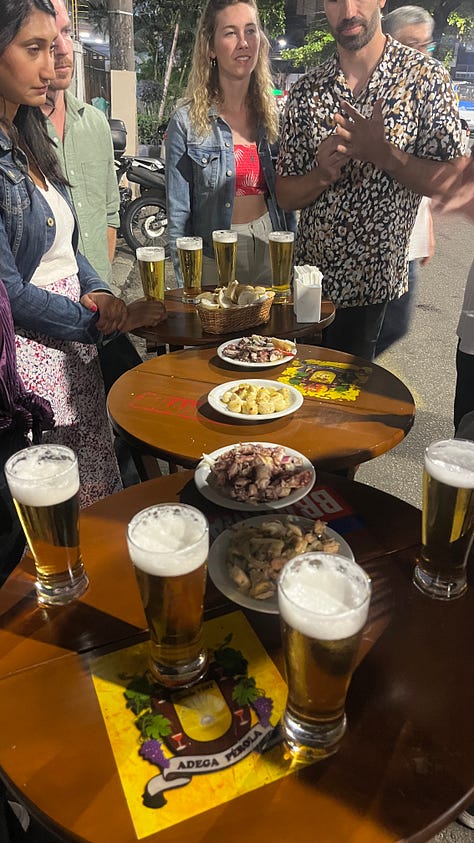
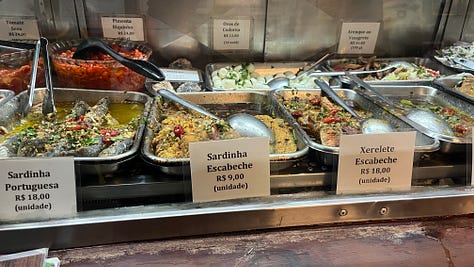



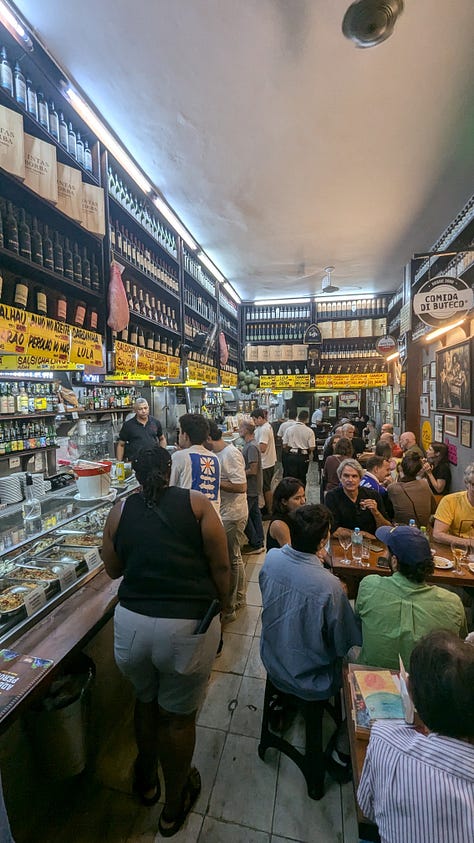
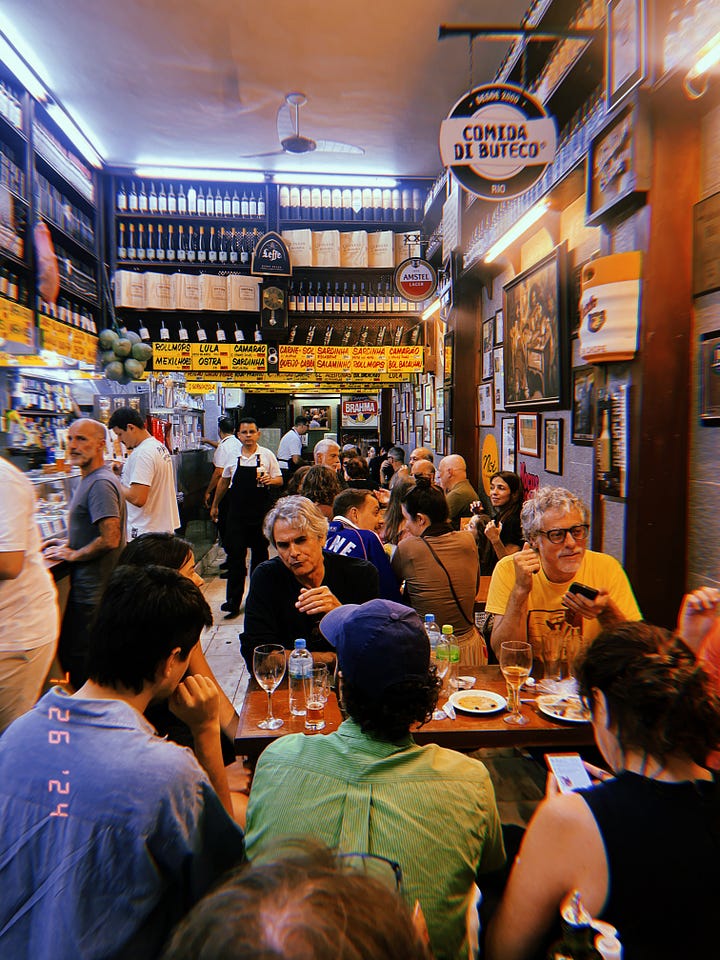

Next, we headed to Pavão Azul Bar, where we enjoyed the best Batidas de Coco3 and Bolinhos de Bacalhau (fried cod balls). Translating to "Blue Peacock" in Portuguese, Pavão Azul is a beloved boteco that epitomizes the Carioca4 spirit. With its tables spilling onto the sidewalk, it’s the perfect spot for socializing over cold beers and traditional Brazilian snacks. The bar's popularity has grown steadily over the years, and in 2011, to accommodate its ever-expanding clientele, the owners opened an additional branch directly across the street from the original location.
While waiting for a table at Pavão Azul, we tried a peanut snack that tasted like peanuts in their raw, pre-peanut-butter state. Let’s just say, I wasn’t a fan. On the bright side, the Batidas de Coco were a hit—they reminded me of Ponche de Crème5, Coquito, and Eggnog, with that same creamy, indulgent vibe. The Californians I was with couldn’t resist asking if they had any made with oat milk. 😂 Spoiler alert: of course, they didn’t.

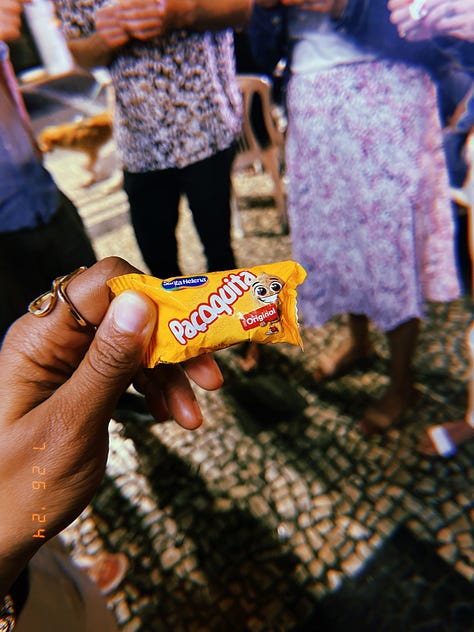
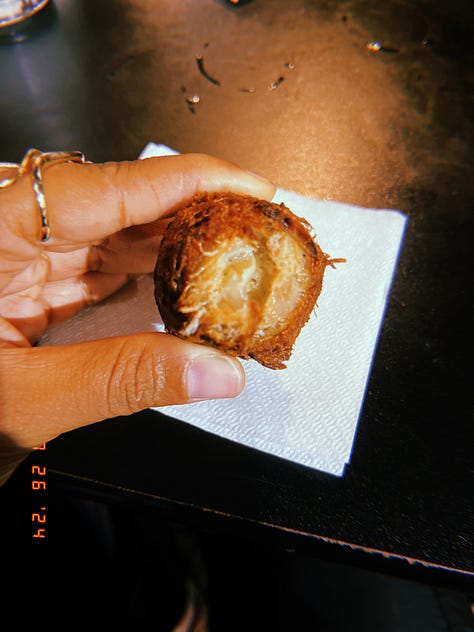
We stopped at a spot that served green wine, made from early-harvested grapes from northern Portugal. While the wine was refreshing and unique, the food wasn’t worth mentioning.
We ended our night outside Bar do David and Galeto Sat's, and by that point, the chopp, Batidas de Coco, and green wine had fully kicked in. Murillo, ever the host, ordered Saudosa Malaca, a dish that earned Bar do David the 2017 Comida di Buteco championship—and let me tell you, it goes HARD. This masterpiece features cornmeal balls filled with creamy goat cheese and stuffed with savory carne-seca (cured beef), paired perfectly with a sweet and tangy pineapple jam. It was so good that I ended up eating it three more times while I was in Rio. Bar do David’s reputation as a culinary standout is well-earned, having secured the Comida di Buteco title three times: in 2016, 2017, and 2022. This place isn’t just serving food—it’s serving champions.


At Galeto Sat's, Murillo introduced us to chicken hearts, and later, we ordered spring chicken to go—and let me tell you, it was finger licking good. By the time the chicken hearts hit the table, we were properly under the influence, which led to some questionable commentary. Someone pointed out the harsh reality that over 50 chickens had to die to serve us this plate, since, obviously, a chicken only has one heart 😂 . I was not ready for that acknowledgment. The overthinking didn’t stop there. As we inspected the hearts, someone noted how much they resembled our hearts and then went on to say that as we chewed, we could taste the four quadrants of the heart. That person was probably me. Yet, despite all the shit-talking, we couldn’t stop eating them. They were just that good.
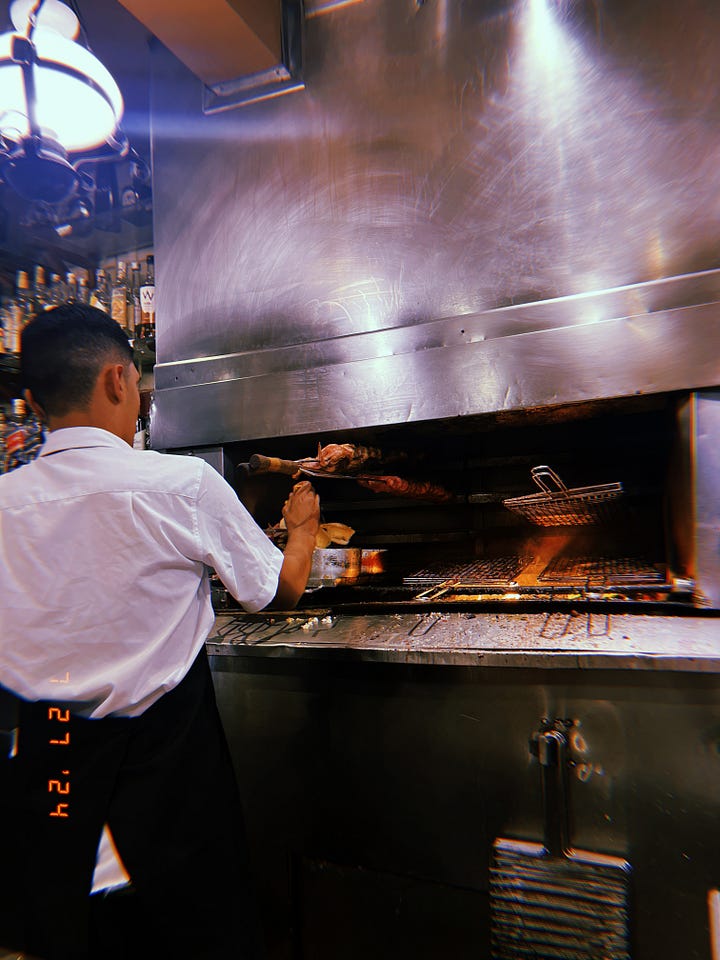

This tour truly highlights the best of the best, and while I’m sharing some of where we went and what we had, it’s worth noting that Murillo does an amazing job of constantly researching, adding new spots, and recreating the Carioca way of life at the bar. So, seriously—do the tour, don’t be cheap. Bars in Rio aren’t just places to grab a drink; they’re an essential part of the culture and lifestyle. They act as extensions of a Carioca’s home and beach life, embodying the casual, social, and vibrant spirit that makes Rio so unique. If you want to want to eat good azz food in Rio, go to the bars.
In Trinidadian slang, the term "commesse" refers to confusion, controversy, or scandal, often associated with arguments, gossip, and slander. It's commonly used to describe situations filled with drama or disorder.
Iberian style draws inspiration from the Iberian Peninsula, encompassing the cultures of Spain and Portugal along with their shared historical influences.
Batidas de coco is a creamy, coconut-based Brazilian cocktail that is both refreshing and indulgent. The term "batida" means "shaken" or "blended" in Portuguese, and these drinks typically combine fruit, sweetened condensed milk, and cachaça (a Brazilian sugarcane spirit), resulting in a smooth and tropical flavor.
Carioca is someone who is born in the city of Rio de Janeiro, Brazil. While originally used strictly for city natives, it can also refer to people who have adopted Rio’s culture and lifestyle, even if they weren’t born there. Cariocas are known for their relaxed, fun-loving attitude and their deep connection to Rio’s natural beauty and cultural traditions.
Ponche de Creme is a traditional Caribbean holiday drink, especially popular in Trinidad and Tobago, with similarities to eggnog. It's a creamy, spiced beverage made with a rich combination of eggs, condensed milk, lime, rum, and aromatic spices. It is a must-have during Christmas celebrations in Trinidadian households.



yes to bar food. yes to bar culture. and hell yes to chicken hearts 🫶🏾